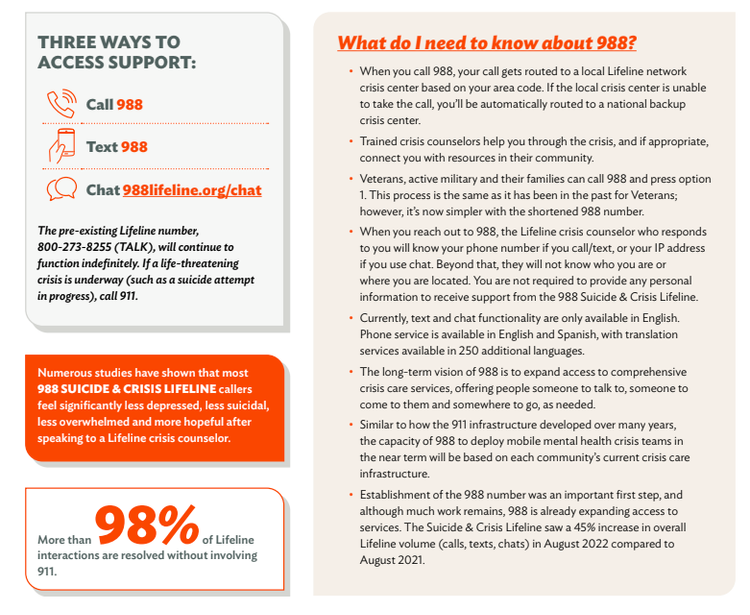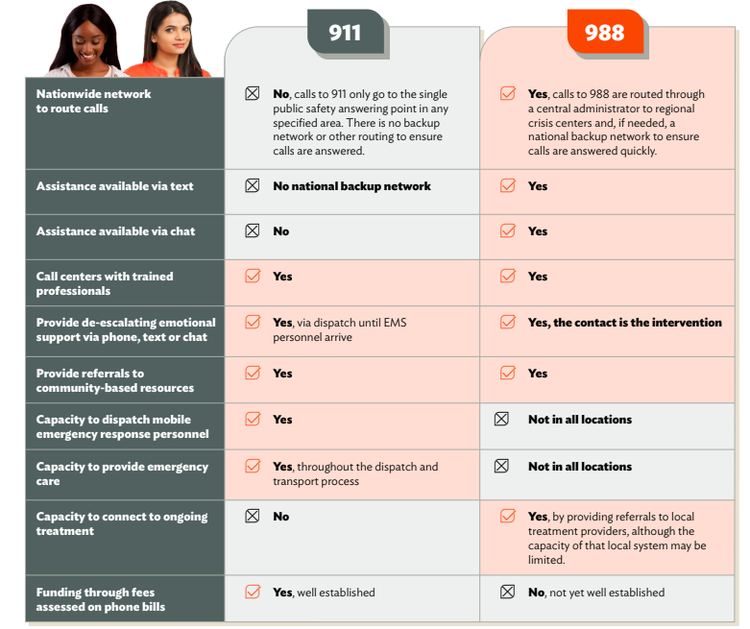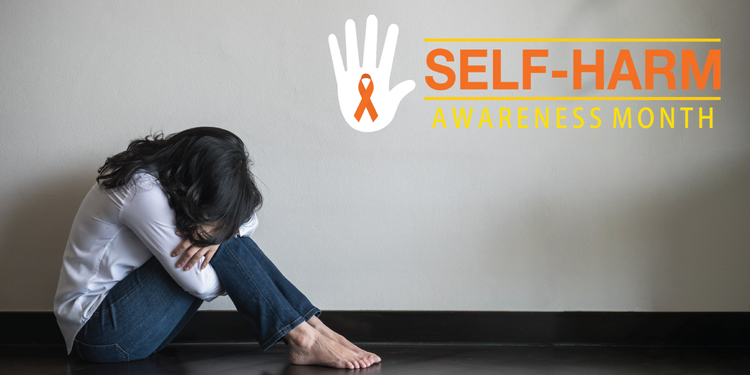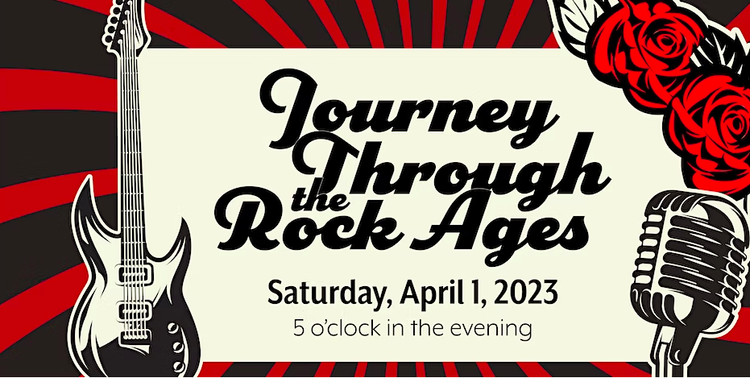March 2023 News!
Happy Spring!
As Minnesotans, we know too well the emphasis we place on the changing seasons. We look for the sunshine and rising temps; we seek out those early buds and blossoms and return of the Robins and other symbols of spring. And after the winter we’ve had (and continue to endure), the arrival of spring could not be more welcomed.
Spring symbolizes rebirth and a return to the light. New beginnings and a fruitful promise of what’s to come. As CNN author David Allan wrote in his column The Wisdom Project on the equinox last week, “Spring signifies coming out of the darkness. We’ve tipped the balance from longer nights to longer days. Equinox means “equal night” of light and dark (roughly), and through the rest of the season we can benefit—experientially and metaphorically—from more time spent in the light.”
We will take it.
Enjoy the sunshine!
Reyne & Scott Roeder
Why Calling 988 Makes a Difference: Know the Facts




March is Self-Harm Awareness Month
How to Protect Those We Love
Penn Foundation | Behavioral Health Service
Self-harm means hurting yourself on purpose. Also known as self-injury, self-harm is a symptom of extreme emotional distress. Individuals, in particular teens, engage in different types of self-harm that can be hard to identify.
According to the Centers for Disease Control and Prevention, up to 30% of teenage girls and 10% of boys say that they have intentionally hurt themselves. One study found that as many as 25% of young people engage in self-injury.
These rates demonstrate a significant increase over the past 10 years, especially among girls. From 2001-2015, self-harm increased 166% in girls aged 10-14 and 62% in girls ages 15-19. Since 2009, the rate of cutting, the most common form of self-harm, among girls ages 10-14 has increased 18.8% each year.
FORMS OF SELF-HARM
Self-harm typically occurs in private and is done in a controlled or ritualistic manner that often leaves a pattern on the skin. Some forms of self-harm include:
- Cutting
- Scratching
- Burning (with lit matches, cigarettes, or heated, sharp objects like knives)
- Carving words or symbols on the skin
- Self-hitting, punching, or head banging
WHY PEOPLE SELF-HARM
There is no one single factor that causes someone to self-harm. Generally speaking, it may result from:
- Poor coping skills: The inability to cope in healthy ways to psychological pain
- Difficult managing emotions: The inability to regulate, express, or understand emotions (The mix of emotions that triggers self-harm is complex and may include feelings of worthlessness, loneliness, panic, anger, guilt, rejection, self-hatred, or confused sexuality.)
Risk Factors:
Self-harm usually begins in adolescence, around the ages of 13 and 14, when emotions are more volatile and teens are facing increased peer pressure, loneliness, and conflicts with parents and other authority figures.
Some factors that may increase the risk of self-harm include:
- Having friends who self-injure
- Life issues such as trauma, abuse, unstable family environment, social isolation, and confusion about personal identity
- Mental health issues (self-harm is commonly associated with borderline personality disorder, depression, anxiety disorders, post-traumatic stress disorder, and eating disorders)
- Drug/alcohol use (people who harm themselves often do so while under the influence of drugs or alcohol)
Warning Signs:
- Scars, often in patterns
- Fresh cuts, scratches, bruises, bite marks, or other wounds
- Keeping sharp objects on hand
- Wearing long sleeves or long pants, even in hot weather
- Frequent reports of accidental injury
- Difficulties in relationships
- Behavioral and emotional instability, impulsivity, and unpredictability
- Statements of helplessness, hopelessness, or worthlessness
Suicide Risk
Although self-harm is not typically a suicide attempt, it can increase the risk of suicide because of the emotional distress that triggers self-injury. And the pattern of hurting the body in times of distress can increase the likelihood of suicide.
Prevention
There is no way to prevent someone from self-harming. But reducing the risk of self-injury includes strategies that involve parents, family members, teachers, school nurses, coaches, and friends.
- Offer help to someone at risk. Someone at risk can be taught healthy coping skills that can be used during periods of distress.
- Encourage social connection. Many people who self-injure feel lonely and disconnected. Helping someone form connections to people who don’t self-injure can improve relationship and communication skills.
- Raise awareness. Learn about the warning signs of self-injury and what to do when you suspect it.
- Reach out for help. Encourage children, teens, and young adults to avoid secrecy and reach out for help if they have a concern about a friend or loved one.
- Talk about media influence. News media, social media, music, and other highly visible outlets that feature self-injury may inspire children and young adults to experiment. Teaching children critical thinking skills about the influences around them might reduce the harmful impact. (see articles below)
Resources for Support:
- Dial 988 to connect to Suicide & Crisis Lifeline
- Call your mental health professional if you are seeing one.
- Seek help from your school nurse or counselor, teacher, doctor, or other health care provider.
- Reach out to a close friend or loved one.
- Contact a spiritual leader or someone else in your faith community

An Evening of Hope
No one should grieve alone—and Bri’s Lodge, a program of What Would Bri Do—is making sure that won’t happen at its annual Evening of Hope on April 1, 2023: A Journey Through the Rock Ages. Bri’s Lodge is a local non-profit committed to helping individuals cope with loss, support their healing, nurture physical and emotional well-being, and bring hope for the future, believing that no one should grieve alone.
Bri’s Lodge continues to build a healing lodge in Central Minnesota for families, and is currently in a temporary space in Midtown Mall to serve those in need. This space will be a weekend retreat center for individuals and families in similar situations to gather and begin to heal after a loss.
Bri’s Lodge currently offers 1:1 Companioning and two support groups; general loss and veterans. Journey Through the Rock Ages is a fundraiser that will help make Bri’s Lodge even more expansive in its reach.
Journey Through the Rock Ages schedule for the evening:
5:00pm—Doors Open at the Best Western Kelly Inn, St. Cloud
-
Cash Bar
-
Silent Auction
-
Games of Chance
-
DJ Music—Journey Through the Rock Ages
6:00pm—Buffet Dinner
6:30pm—Presentation and Guest Speakers
8:30pm—Silent Auction Closing
-
Jewelry Box Raffle Reveal
-
Door Prize Drawing
9:00pm—Silent Auction Cash Out
St. Cloud Area Sertoma Club
Thank You for Supporting Jackson’s Fund
SERTOMA—SERvice TO MANkind—is a community service organization that puts its focus on helping the healthcare community.
The St. Cloud Area Sertoma club donated $1,000 to Jackson’s fund so we too can continue to serve humankind through our efforts in suicide prevention and mental health.
We are blessed by your generosity!

Resources & Can't-Miss:
Military Mental Health Coalition “Stomp the Stigma”
Conference at Camp Ripley to increase awareness of military mental health including suicide prevention, PTSD, selfcare, and resources for families. Friday April 28th 8am-4:30pm. Register here.
Modern Approaches to Mental Health
Workshop combining perspective from three area mental health organizations on modern healthcare for current issues related to wellbeing and mental health support. Thursday, April 6th 7pm-8pm at Mindology Wellness Center in St. Cloud.
Camp GK Bear for Kids
Camp GK Bear is a one-day camp for children, grades K-6, who have experienced a significant death in their lives. The day camp combines art, music, and fun with grief education and support. Free registration. Saturday, April 29th 10am-3pm at Rice Memorial Hospital in Willmar.
National Suicide & Crisis Lifeline
Call or text 988.
